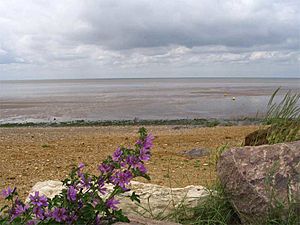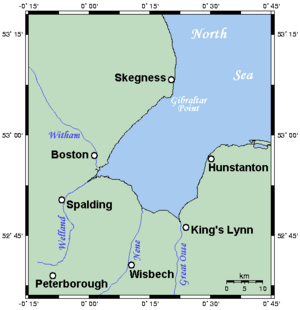The Wash facts for kids
The Wash is a large, square-shaped estuary located on the east coast of England. It's where the county of Norfolk meets Lincolnshire. This important area is one of the biggest estuaries in the United Kingdom. It's also recognized as a special wetland site by the Ramsar Convention, which means it's very important for nature and wildlife.
Geography of The Wash
The Wash looks like a big bite taken out of the eastern coastline of England on a map. It acts as a natural border, separating the curved coast of East Anglia from Lincolnshire. The Wash has three sides that are mostly straight, forming a right angle. Each side is about 25 kilometres (15 miles) long.
The eastern side of The Wash is entirely within Norfolk. It stretches from Hunstanton in the north down to the mouth of the River Great Ouse at King's Lynn in the south. The opposite side, to the west, is in Lincolnshire. It runs from Gibraltar Point to the mouth of the River Welland. The southern side of The Wash connects these two river mouths, running from northwest to southeast. In the middle of this southern coast, you'll find the mouth of a third important river, the River Nene.
The Historical Story of King John
One of the most famous stories about The Wash involves King John and his lost crown. This event is said to have happened in the year 1216.
According to historical reports, King John was traveling from Spalding in Lincolnshire to Bishop's Lynn in Norfolk. He became unwell and decided to return. While King John took a longer, safer route through Wisbech, he sent his valuable belongings, including his crown jewels, along a different path. This path went along the seashore and across the mouth of the Wellstream river. This route was only safe when the tide was low and the water was shallow.
However, the wagons carrying his treasures were pulled by horses and moved too slowly. The incoming tide quickly rose, covering the path. Many of the wagons and their contents, including the crown jewels, were lost to the sea. At that time, the entire area around The Wash was a vast wetland known as The Fens. This marshy land was later drained to create farmland, but it remains very close to sea level.
Images for kids
-
The jetty at Snettisham RSPB reserve, a great place for birdwatching.
See also
 In Spanish: Estuario del Wash para niños
In Spanish: Estuario del Wash para niños





